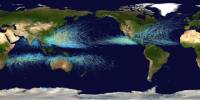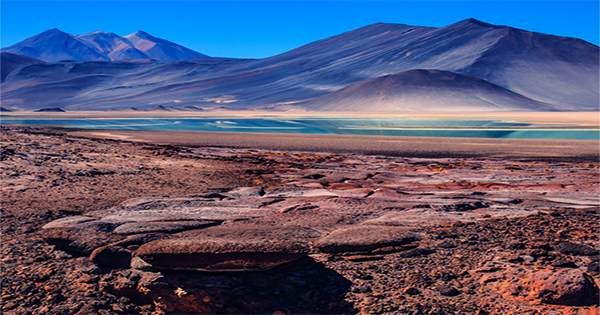According to new research from Rice University, banded iron formations are sedimentary rocks that feature spectacular layers of burned orange, yellow, silver, brown, and blue-tinged black. These layers are typical of sedimentary rocks that may have caused some of the biggest volcanic eruptions in Earth’s history.
Iron oxides that were once on the ocean’s bottom and formed thick layers before becoming stone are present in the rocks. According to a study published this week in Nature Geoscience, the iron-rich strata may link planetary processes like volcanism and plate tectonics to ancient changes at the Earth’s surface like the development of photosynthetic life.
The discovery could reframe scientists’ understanding of Earth’s early history and provide insight into mechanisms that could produce habitable exoplanets far from our solar system in addition to linking planetary processes that were previously thought to be unconnected.
“These rocks tell quite literally the story of a changing planetary environment,” said Duncan Keller, the study’s lead author and a postdoctoral researcher in Rice’s Department of Earth, Environmental and Planetary Sciences. “They embody a change in the atmospheric and ocean chemistry.”
Banded iron formations are chemical deposits that directly formed from iron-rich, ancient seawater. The minerals were supposed to have precipitated more easily thanks to the metabolic activities of microbes, including photosynthesis, which created layers upon layers of chert (microcrystalline silicon dioxide) over time. The largest deposits formed as oxygen accumulated in Earth’s atmosphere about 2.5 billion years ago.
“These rocks formed in the ancient oceans, and we know that those oceans were later closed up laterally by plate tectonic processes,” Keller explained.
The mantle, though solid, flows like a fluid at about the rate that fingernails grow. Tectonic plates continent-sized sections of the crust and uppermost mantle are constantly on the move, largely as a result of thermal convection currents in the mantle. Earth’s tectonic processes control the life cycles of oceans.
This is an extremely interdisciplinary collaboration that’s looking at how volatile elements that are important for biology carbon, hydrogen, nitrogen, oxygen, phosphorus and sulfur behave in planets, at how planets acquire these elements and the role they play in potentially making planets habitable. We’re using Earth as the best example that we have, but we’re trying to figure out what the presence or absence of one or some of these elements might mean for planets more generally.
Duncan Keller
“Just like the Pacific Ocean is being closed today it’s subducting under Japan and under South America ancient ocean basins were destroyed tectonically,” he said. “These rocks either had to get pushed up onto continents and be preserved and we do see some preserved, that’s where the ones we’re looking at today come from or subducted into the mantle.”
Keller wondered if subducted pieces of the formations sank all the way down and landed in the lowest region of the mantle at the top of Earth’s core because banded iron formations are denser than the mantle due to their high iron content. They would have undergone significant modifications as their minerals took on new structures there, under extreme temperatures and pressure.
“There’s some very interesting work on the properties of iron oxides at those conditions,” Keller said. “They can become highly thermally and electrically conductive. Some of them transfer heat as easily as metals do. So it’s possible that, once in the lower mantle, these rocks would turn into extremely conductive lumps like hot plates.”
According to Keller and his colleagues, areas rich in subducted iron formations may facilitate the development of mantle plumes, rising conduits of hot rock above thermal anomalies in the lower mantle that can result in massive volcanoes like those that created the Hawaiian Islands.
“Underneath Hawaii, seismological data show us a hot conduit of upwelling mantle,” Keller said. “Imagine a hot spot on your stove burner. As the water in your pot is boiling, you’ll see more bubbles over a column of rising water in that area. Mantle plumes are sort of a giant version of that.”
“We looked at the depositional ages of banded iron formations and the ages of large basaltic eruption events called large igneous provinces, and we found that there’s a correlation,” Keller said. “Many of the igneous events which were so massive that the 10 or 15 largest may have been enough to resurface the entire planet were preceded by banded iron formation deposition at intervals of roughly 241 million years, give or take 15 million. It’s a strong correlation with a mechanism that makes sense.”
The research demonstrated that a period of time might have passed between banded iron formations being pushed into the lower mantle and influencing heat flow to send a plume toward the Earth’s surface from thousands of kilometers above.
In his effort to trace the journey of banded iron formations, Keller crossed disciplinary boundaries and ran into unexpected insights.
“If what’s happening in the early oceans, after microorganisms chemically change surface environments, ultimately creates an enormous outpouring of lava somewhere else on Earth 250 million years later, that means these processes are related and ‘talking’ to each other,” Keller said. “It also means it’s possible for related processes to have length scales that are far greater than people expected. To be able to infer this, we’ve had to draw on data from many different fields across mineralogy, geochemistry, geophysics and sedimentology.”
Keller hopes the study will spur further research. “I hope this motivates people in the different fields that it touches,” he said. “I think it would be really cool if this got people talking to each other in renewed ways about how different parts of the Earth system are connected.”
Keller is part of the CLEVER Planets: Cycles of Life-Essential Volatile Elements in Rocky Planets program, an interdisciplinary, multi-institutional group of scientists led by Rajdeep Dasgupta, Rice’s W. Maurice Ewing Professor of Earth Systems Science in the Department of Earth, Environmental and Planetary Sciences.
“This is an extremely interdisciplinary collaboration that’s looking at how volatile elements that are important for biology carbon, hydrogen, nitrogen, oxygen, phosphorus and sulfur behave in planets, at how planets acquire these elements and the role they play in potentially making planets habitable,” Keller said.
“We’re using Earth as the best example that we have, but we’re trying to figure out what the presence or absence of one or some of these elements might mean for planets more generally,” he added.
















